Western world
Western world
This article is about the grouping of countries with an originally European shared culture. For other uses, see Western World (disambiguation).
"Western power" and "Westerners" redirect here. For historical politics in Korea, see Westerners (Korean political faction). For other uses, see Western Power (disambiguation). The Western world as derived from Samuel P. Huntington's 1996 Clash of Civilizations:[1] in light blue are Latin America and the Orthodox World, which are either a part of the West or distinct civilizations intimately related to the West.[2][3]
The Western world as derived from Samuel P. Huntington's 1996 Clash of Civilizations:[1] in light blue are Latin America and the Orthodox World, which are either a part of the West or distinct civilizations intimately related to the West.[2][3]
The Western world, also known as the West, primarily refers to various nations and states in the regions of Australasia,[a] Western Europe, and Northern America;[4] with some debate as to whether Eastern Europe and Latin America[b] also constitute the West.[6][7] The Western world likewise is called the Occident (from Latin occidens 'setting down, sunset, west') in contrast to the Eastern world known as the Orient (from Latin oriens 'origin, sunrise, east'). The West is considered an evolving concept; made up of cultural, political, and economic synergy among diverse groups of people, and not a rigid region with fixed borders and members.[8] Definitions of "Western world" vary according to context and perspectives.[9]
Modern-day Western world essentially encompasses the nations and states where civilization or culture is considered Western[10][11][12]—the roots of which some historians have traced to the Greco-Roman world and Christianity.[13][14] In the Global North–South schism, the West is often correlated with Global North.[15][16] A historic idea of Europe as the geographic West emerged in the fifth century BCE Greece.[17][18][19] A geographical concept of the West started to take shape in the 4th century CE when Constantine, the first Christian Roman emperor, divided the Roman Empire between the Greek East and Latin West. The East Roman Empire, later called the Byzantine Empire, continued for a millennium, while the West Roman Empire lasted for only about a century and a half. This caused many people in Western Europe to envy the Byzantine Empire and consider the Christians there as heretics.[9] In 1054 CE, when the church in Rome excommunicated the patriarch of Byzantium, the politico-religious division between the Western church and Eastern church culminated in the Great Schism or the East–West Schism.[9][20] Even though friendly relations continued between the two parts of the Christendom for some time, the crusades made the schism definitive with hostility.[21] The West during these crusades tried to capture trade routes to the East and failed, it instead discovered the Americas.[22] In the aftermath of European colonization of these newly discovered lands, an idea of the Western world, as an inheritor of Latin Christendom emerged.[23]
The English word "West" was initially meant an adverb for direction. By the Middle Ages, Europeans began to use it to describe Europe. Since the eighteenth century, following European exploration, the word was used to indicate the regions of the world with European settlements.[24][25][26] In contemporary times, countries that are considered to constitute the West vary according to perspective rather than their geographical location. Countries like Australia and New Zealand, located in the Eastern Hemisphere are included in modern definitions of the Western world,[27] as these regions and others like them have been significantly influenced by the British—derived from colonization, and immigration of Europeans—factors that grounded such countries to the West.[28] Despite being located in the Far East, a country like Japan, in some contexts, is considered a part of the West as it aligns with the ideals of Western-style democracy; while a country like Cuba, located in the Western Hemisphere, is argued as not being a part of the West as it aligns with the ideals of communism.[29] Depending on the context and the historical period in question, Russia was sometimes seen as a part of the West, and at other times juxtaposed with it.[30][31][32] Running parallel to the rise of the United States as a great power and the development of communication–transportation technologies "shrinking" the distance between both the Atlantic Ocean shores, the aforementioned country (United States) became more prominently featured in the conceptualizations of the West.[30]
Between the eighteenth century to the mid-twentieth century, prominent countries in the West such as the United States, Canada, Brazil, Argentina, Australia, and New Zealand have been once envisioned as ethnocracies for whites.[33][34][35] Racism is cited as a contributing factor to Westerners' colonization of the New World, which today constitutes much of the "geographical" Western world.[36][37] Starting from the late 1960s, certain parts of the Western World have become notable for their diversity due to immigration.[38][39] The idea of "the West" over the course of time has evolved from a directional concept to a socio-political concept that had been temporalized and rendered as a concept of the future bestowed with notions of progress and modernity.[30]
Introduction
The origins of Western civilization can be traced back to the ancient Mediterranean world. Ancient Greece[c] and Ancient Rome[d] are generally considered to be the birthplaces of Western civilization—Greece having heavily influenced Rome—the former due to its impact on philosophy, democracy, science, aesthetics, as well as building designs and proportions and architecture; the latter due to its influence on art, law, warfare, governance, republicanism, engineering and religion. Western Civilization is also closely associated with Christianity,[58] the dominant religion in the West, with roots in Greco-Roman and Jewish thought. Christian ethics, drawing from the ethical and moral principles of its historical roots in Judaism, has played a pivotal role in shaping the foundational framework of Western societies.[59][60][61] Earlier civilizations, such as the ancient Egyptians and Mesopotamians, had also significantly influenced Western civilization through their advancements in writing, law codes, and societal structures.[58] The convergence of Greek-Roman and Judeo-Christian influences in shaping Western civilization has led certain scholars to characterize it as emerging from the legacies of Athens and Jerusalem,[62][63][64] or Athens, Jerusalem and Rome.[65]
In ancient Greece and Rome, individuals identified primarily as subjects of states, city-states, or empires, rather than as members of Western civilization. The distinct identification of Western civilization began to crystallize with the rise of Christianity during the Late Roman Empire. In this period, peoples in Europe started to perceive themselves as part of a unique civilization, differentiating from others like Islam, giving rise to the concept of Western civilization. By the 15th century, Renaissance intellectuals solidified this concept, associating Western civilization not only with Christianity but also with the intellectual and political achievements of the ancient Greeks and Romans.[58]
Historians, such as Carroll Quigley in "The Evolution of Civilizations",[66] contend that Western civilization was born around AD 500, after the fall of the Western Roman Empire, leaving a vacuum for new ideas to flourish that were impossible in Classical societies. In either view, between the fall of the Western Roman Empire and the Renaissance, the West (or those regions that would later become the heartland of the culturally "western sphere") experienced a period of decline, and then readaptation, reorientation and considerable renewed material, technological and political development.[67] Classical culture of the ancient Western world was partly preserved during this period due to the survival of the Eastern Roman Empire and the introduction of the Catholic Church; it was also greatly expanded by the Arab importation[68][69] of both the Ancient Greco-Roman and new technology through the Arabs from India and China to Europe.[70][71] Gold and garnet cloisonné (and mud), military fitting from the Staffordshire Hoard before cleaning
Gold and garnet cloisonné (and mud), military fitting from the Staffordshire Hoard before cleaning
Since the Renaissance, the West evolved beyond the influence of the ancient Greeks and Romans and the Islamic world, due to the successful Second Agricultural, Commercial,[72] Scientific,[73] and Industrial[74] revolutions (propellers of modern banking concepts). The West rose further with the 18th century's Age of Enlightenment and through the Age of Exploration's expansion of peoples of Western and Central European empires, particularly the globe-spanning colonial empires of 18th and 19th centuries.[75] Numerous times, this expansion was accompanied by Catholic missionaries, who attempted to proselytize Christianity. US Supreme Court (1932—1935) building, built in neoclassical style, an architectural style of the Western world
US Supreme Court (1932—1935) building, built in neoclassical style, an architectural style of the Western world
In the modern era, Western culture has undergone further transformation through the Renaissance, Ages of Discovery and Enlightenment, and the Industrial and Scientific Revolutions.[76][77] The widespread influence of Western culture extended globally through imperialism, colonialism, and Christianization by Western powers from the 15th to 20th centuries. This influence persists through the exportation of mass culture, a phenomenon often referred to as Westernization.[78]
There was debate among some in the 1960s as to whether Latin America as a whole is in a category of its own.[79]
Culture
Further information: Western Europe and Eastern Europe
This section is an excerpt from Western culture.[edit] Leonardo da Vinci's Vitruvian Man, based on the correlations of ideal human proportions with geometry described by the ancient Roman architect Vitruvius in Book III of his treatise De architectura
Leonardo da Vinci's Vitruvian Man, based on the correlations of ideal human proportions with geometry described by the ancient Roman architect Vitruvius in Book III of his treatise De architectura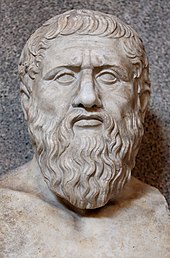 Plato, arguably the most influential figure in early Western philosophy, has influenced virtually all of subsequent Western and Middle Eastern philosophy and theology
Plato, arguably the most influential figure in early Western philosophy, has influenced virtually all of subsequent Western and Middle Eastern philosophy and theology
Western culture, also known as Western civilization, European civilization, Occidental culture, or Western society, is an umbrella term which refers to the diverse heritages of social norms, ethical values, traditional customs, belief systems, political systems, artifacts and technologies of the Western world. Western civilization, broadly defined, finds its roots in the foundations laid by Greco-Roman civilization, and the tenets of Western Christianity.[80][81][82][83][84][85][86][87][88] It has also been substantially influenced by societal influences from Germanic peoples. Whilst Western culture is a broad concept, and does not relate to a region with fixed members or geographical confines, it may relate to the cultures of countries with historical ties to a European country or a number of European countries, or the variety of cultures within Europe itself. However, countries toward the east of Europe are sometimes excluded from definitions of the Western world.
Western culture is characterized by a host of artistic, philosophic, literary and legal themes and traditions. Christianity, primarily the Catholic Church,[89][90][91] and later Protestantism[92][93][94][95] has played a prominent role in the shaping of Western civilization since at least the 4th century,[96][97][98][99][100] as did Judaism.[101][102][103][104] A cornerstone of Western thought, beginning in ancient Greece and continuing through the Middle Ages and Renaissance, is the idea of rationalism in various spheres of life developed by Hellenistic philosophy, scholasticism and humanism. Empiricism later gave rise to the scientific method, the scientific revolution, and the Age of Enlightenment.
While traditionally shunned as a mainspring of Western civilization in favour of early Aegean cultures, the Phoenician city-states stimulated and fostered Western civilization.[105] The expansion of Greek culture into the Hellenistic world of the eastern Mediterranean led to a synthesis between Greek and Near-Eastern cultures,[106] and major advances in literature, engineering, and science, and provided the culture for the expansion of early Christianity and the Greek New Testament.[107][108][109] This period overlapped with and was followed by Rome, which made key contributions in law, government, engineering and political organization.[110]
Western culture continued to develop with the Christianization of European society during the Middle Ages, the reforms triggered by the medieval renaissances, the influence of the Islamic world via Al-Andalus and Sicily (including the transfer of technology from the East, and Latin translations of Arabic texts on science and philosophy by Greek and Hellenic-influenced Islamic philosophers),[111][112][113] and the Italian Renaissance as Greek scholars fleeing after the fall of Constantinople brought classical traditions and philosophy.[114] This major change for non-Western countries and their people saw a development in modernization in those countries.[115] Medieval Christianity is credited with creating the modern university,[116][117] the modern hospital system,[118] scientific economics,[119][120] and natural law (which would later influence the creation of international law).[121] Christianity played a role in ending practices common among European pagans at the time, such as human sacrifice and infanticide.[122] European culture developed with a complex range of philosophy, medieval scholasticism, mysticism and Christian and secular humanism.[123][page needed] Rational thinking developed through a long age of change and formation, with the experiments of the Enlightenment and breakthroughs in the sciences. Tendencies that have come to define modern Western societies include the concept of political pluralism, individualism, prominent subcultures or countercultures (such as New Age movements) and increasing cultural syncretism resulting from globalization and human migration.
Historical divisions
 This section needs additional citations for verification. Please help improve this article by adding citations to reliable sources in this section. Unsourced material may be challenged and removed. (July 2018) (Learn how and when to remove this template message)
This section needs additional citations for verification. Please help improve this article by adding citations to reliable sources in this section. Unsourced material may be challenged and removed. (July 2018) (Learn how and when to remove this template message)
The West of the Mediterranean Region during the Antiquity
The geopolitical divisions in Europe that created a concept of East and West originated in the ancient tyrannical and imperialistic Graeco-Roman times.[124] The Eastern Mediterranean was home to the highly urbanized cultures that had Greek as their common language (owing to the older empire of Alexander the Great and of the Hellenistic successors), whereas the West was much more rural in its character and more readily adopted Latin as its common language. After the fall of the Western Roman Empire and the beginning of the Medieval times (or Middle Ages), Western and Central Europe were substantially cut off from the East where Byzantine Greek culture and Eastern Christianity became founding influences in the Eastern European world such as the East and South Slavic peoples.[citation needed]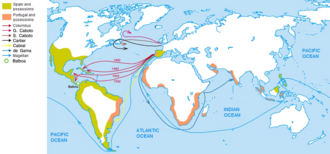 The main travels of the Age of Discovery (began in 15th century)
The main travels of the Age of Discovery (began in 15th century)
Roman Catholic Western and Central Europe, as such, maintained a distinct identity particularly as it began to redevelop during the Renaissance. Even following the Protestant Reformation, Protestant Europe continued to see itself as more tied to Roman Catholic Europe than other parts of the perceived civilized world. Use of the term West as a specific cultural and geopolitical term developed over the course of the Age of Exploration as Europe spread its culture to other parts of the world. Roman Catholics were the first major religious group to immigrate to the New World, as settlers in the colonies of Spain and Portugal (and later, France) belonged to that faith. English and Dutch colonies, on the other hand, tended to be more religiously diverse. Settlers to these colonies included Anglicans, Dutch Calvinists, English Puritans and other nonconformists, English Catholics, Scottish Presbyterians, French Huguenots, German and Swedish Lutherans, as well as Quakers, Mennonites, Amish, and Moravians.[citation needed]
Ancient Greek and Hellenistic worlds (13th–1st centuries BC)
Main articles: Ancient Greece and Hellenistic period This section needs additional citations for verification. Please help improve this article by adding citations to reliable sources in this section. Unsourced material may be challenged and removed. (November 2021) (Learn how and when to remove this template message)
This section needs additional citations for verification. Please help improve this article by adding citations to reliable sources in this section. Unsourced material may be challenged and removed. (November 2021) (Learn how and when to remove this template message) This article may need to be rewritten to comply with Wikipedia's quality standards, as neutrality is disputed. You can help. The talk page may contain suggestions. (November 2021)
This article may need to be rewritten to comply with Wikipedia's quality standards, as neutrality is disputed. You can help. The talk page may contain suggestions. (November 2021)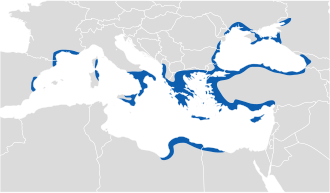 The ancient Greek world, c. 550 BC
The ancient Greek world, c. 550 BC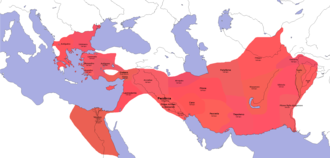 The ancient Hellenistic Greek world from 323 BC
The ancient Hellenistic Greek world from 323 BC
The ancient Greek civilization had been growing in the first millennium BC into wealthy poleis, so-called city-states (geographically loose political entities which in time, inevitably end giving way to larger organisations of society, including the empire and the nation-state)[125] such as Athens, Sparta, Thebes, and Corinth, by Middle and Near Eastern ones (Sumerian cities such as Uruk and Ur; Ancient Egyptian city-states, such as Thebes and Memphis; the Phoenician Tyre and Sidon; the five Philistine city-states; the Berber city-states of the Garamantes).[citation needed]
The then Hellenic division between the barbarians (term used by Ancient Greeks for all non-Greek-speaking people) and the Greeks contrasted in many societies the Greek-speaking culture of the Greek settlements around the Mediterranean to the surrounding non-Greek cultures. Herodotus considered the Persian Wars of the early 5th century BC a conflict of Europa versus Asia (which he considered all land north and east of the Sea of Marmara, respectively).[citation needed] The Greeks would highlight what they perceived as a lack of freedom in the Persian world, something that they viewed as antithetical to their culture.[126]
According to a few writers, the future conquest of parts of the Roman Empire by Germanic peoples and the subsequent dominance by the Western Christian papacy (which held combined political and spiritual authority, a state of affairs absent from Greek civilization in all its stages), resulted in a rupture of the previously existing ties between the Latin West and Greek thought,[127] including Christian Greek thought.[citation needed]
Ancient Roman world (6th century BC – AD 395–476)
Main articles: Roman Republic, Roman Empire, and Fall of the Western Roman Empire This section needs additional citations for verification. Please help improve this article by adding citations to reliable sources in this section. Unsourced material may be challenged and removed. (April 2018) (Learn how and when to remove this template message)
This section needs additional citations for verification. Please help improve this article by adding citations to reliable sources in this section. Unsourced material may be challenged and removed. (April 2018) (Learn how and when to remove this template message) This article may need to be rewritten to comply with Wikipedia's quality standards, as neutrality is disputed. You can help. The talk page may contain suggestions. (November 2021)
This article may need to be rewritten to comply with Wikipedia's quality standards, as neutrality is disputed. You can help. The talk page may contain suggestions. (November 2021)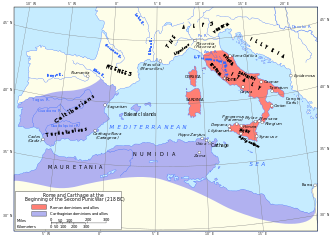 The Roman Republic in 218 BC after having managed the conquest of most of the Italian peninsula, on the eve of its most successful and deadliest war with the Carthaginians
The Roman Republic in 218 BC after having managed the conquest of most of the Italian peninsula, on the eve of its most successful and deadliest war with the Carthaginians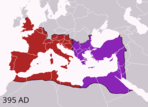

 The Roman Empire in AD 117. During 350 years the Roman Republic turned into an Empire expanding up to twenty-five times its area.
The Roman Empire in AD 117. During 350 years the Roman Republic turned into an Empire expanding up to twenty-five times its area.
Ancient Rome (6th century BC – AD 476) is a term to describe the ancient Roman society that conquered Central Italy assimilating the Italian Etruscan culture, growing from the Latium region since about the 8th century BC, to a massive empire straddling the Mediterranean Sea. In its 10-centuries territorial expansion, Roman civilization shifted from a small monarchy (753–509 BC), to a republic (509–27 BC), into an autocratic empire (27 BC – AD 476). Its Empire came to dominate Western, Central and Southeastern Europe, Northern Africa and, becoming an autocratic Empire a vast Middle Eastern area, when it ended. Conquest was enforced using the Roman legions and then through cultural assimilation by eventual recognition of some form of Roman citizenship's privileges. Nonetheless, despite its great legacy, a number of factors led to the eventual decline and ultimately fall of the Roman Empire.[citation needed]
The Roman Empire succeeded the approximately 500-year-old Roman Republic (c. 510–30 BC).[e] In 350 years, from the successful and deadliest war with the Phoenicians began in 218 BC to the rule of Emperor Hadrian by AD 117, Ancient Rome expanded up to twenty-five times its area. The same time passed before its fall in AD 476. Rome had expanded long before the empire reached its zenith with the conquest of Dacia in AD 106 (modern-day Romania) under Emperor Trajan. During its territorial peak, the Roman Empire controlled about 5,000,000 square kilometres (1,900,000 sq mi) of land surface and had a population of 100 million. From the time of Caesar (100–44 BC) to the Fall of the Western Roman Empire, Rome dominated Southern Europe, the Mediterranean coast of Northern Africa and the Levant, including the ancient trade routes with population living outside. Ancient Rome has contributed greatly to the development of law, war, art, literature, architecture, technology and language in the Western world, and its history continues to have a major influence on the world today. Latin language has been the base from which Romance languages evolved and it has been the official language of the Catholic Church and all Catholic religious ceremonies all over Europe until 1967, as well as an or the official language of countries such as Italy and Poland (9th–18th centuries).[128][citation needed] Ending invasions on Roman Empire since the 2nd and throughout the 5th centuries
Ending invasions on Roman Empire since the 2nd and throughout the 5th centuries
In AD 395, a few decades before its Western collapse, the Roman Empire formally split into a Western and an Eastern one, each with their own emperors, capitals, and governments, although ostensibly they still belonged to one formal Empire. The Western Roman Empire provinces eventually were replaced by Northern European Germanic ruled kingdoms in the 5th century due to civil wars, corruption, and devastating Germanic invasions from such tribes as the Huns, Goths, the Franks and the Vandals by their late expansion throughout Europe. The three-day Visigoths's AD 410 sack of Rome who had been raiding Greece not long before, a shocking time for Greco-Romans, was the first time after almost 800 years that Rome had fallen to a foreign enemy, and St. Jerome, living in Bethlehem at the time, wrote that "The City which had taken the whole world was itself taken."[129] There followed the sack of AD 455 lasting 14 days, this time conducted by the Vandals, retaining Rome's eternal spirit through the Holy See of Rome (the Latin Church) for centuries to come.[130][131] The ancient Barbarian tribes, often composed of well-trained Roman soldiers paid by Rome to guard the extensive borders, had become militarily sophisticated "Romanized barbarians", and mercilessly slaughtered the Romans conquering their Western territories while looting their possessions.[132]
The Roman Empire is where the idea of "the West" began to emerge.[f]
The Eastern Roman Empire, governed from Constantinople, is usually referred to as the Byzantine Empire after AD 476, the traditional date for the fall of the Roman Empire and beginning of the Early Middle Ages. The survival of the Eastern Roman Empire protected Roman legal and cultural traditions, combining them with Greek and Christian elements, for another thousand years. The name Byzantine Empire was first used centuries later, after the Byzantine Empire ended. The dissolution of the Western half, nominally ended in AD 476, but in truth a long process that ended by the rise of Catholic Gaul (modern-day France) ruling from around the year AD 800, left only the Eastern Roman Empire alive. The Eastern half continued to think of itself as the Eastern Roman Empire until AD 610–800, when Latin ceased to be the official language of the empire. The inhabitants called themselves Romans because the term "Roman" was meant to signify all Christians. The Pope crowned Charlemagne as Emperor of the Romans of the newly established Holy Roman Empire, and the West began thinking in terms of Western Latins living in the old Western Empire, and Eastern Greeks (those inside the Roman remnant of the old Eastern Empire).[133]

















































